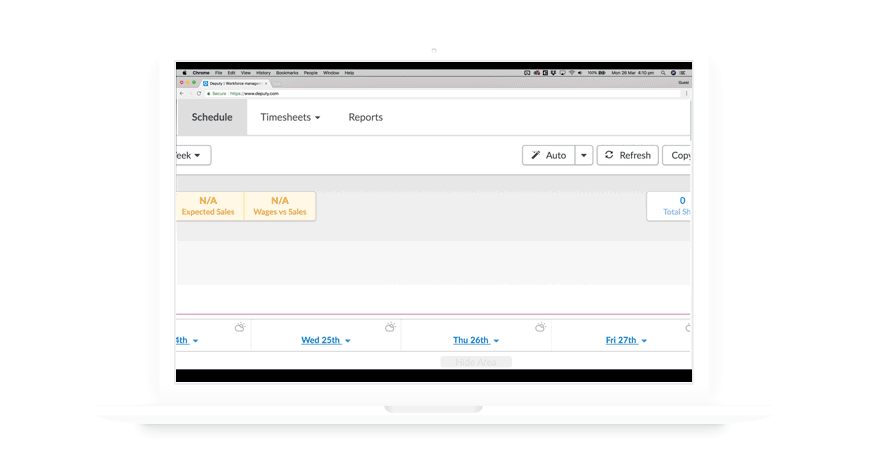Research – Hard Proof that Stable Scheduling can Increase Your Revenue by 7%
Rent, labor costs, vendors, repairs, kitchen equipment, POS systems, employee uniforms, these are all just a handful of costs that business owners must cover to ensure their business runs smoothly & efficiently. It’s understandable that these costs (along with the other general headaches of running a retail business) drive business owners insane. To the point where they begin to try and come up with ways to save them money.
And when it comes to saving cash in business operations, there’s typically one area where business owners are willing to cut corners to ensure they’re able to save some cash. It can’t be inventory because no matter how expensive you’re inventory may be, you still need it in order to make any revenue. And it isn’t equipment because they need equipment to ensure their store runs smoothly. So what area is left that is vulnerable to business owners trying to cut costs…if you guessed labor costs, then you guessed correctly.

Unfortunately for many businesses all over the world (and the employees employed at these businesses), labor is typically an area where costs are cut once the budget starts to get thin.
But a recent research study found that not only is cutting labor costs ineffective for increasing revenue but that they’re actually losing out on profit by cutting back on labor.
Why are business owners struggling for more revenue anyway?
It’s no question that we’re in the golden age of e-commerce, just look at how much money Jeff Bezos (the founder & CEO of Amazon) is worth…no seriously look it up, the guy is making over $200,000 each minute.
His growing net worth is all due in part to the rise of online shopping, retail business owners have been struggling for years now to compete with the convenience and efficiency offered by online shopping and it’s starting to show. Iconic brands that have been around for years like Sears and Toys “R” Us are closing down and many others are struggling to find a solution to keep their doors open. To get a better idea of what these retailers are experiencing, take a look at this example.

You go to a shoe store to buy a particular pair of shoes you’re interested in only to find out it’s completely sold out in the size you’re looking for. So you pull out your phone, google the name of the shoe along with the size you’re looking for, and are instantly given numerous results of online shops that hold the shoe in your particular size. With a couple of swipes and touches of your finger, you now have the shoe currently being shipped to your house.
The above example is why so many business owners are scrambling to figure out where they can save some cash, they’re finding it difficult to compete with brands that have their own dedicated online shops that offer larger inventory as well as the convenience of not having to leave your couch to go shopping.
Why is labor the first area business owners typically turn to?
As stated a bit above, labor costs are typically the only area where business owners find it plausible to cut costs because cutting costs in other areas would have a very direct & obvious negative impact on their business operations.

What these business owners don’t realize is that not only will cutting labor costs not save them money, but it will actually result in a large drop in revenue in the long run.
Hard proof backed by research
A 2015 research study that set out to test the effects of stable scheduling on business results, used employees at 28 Gap locations all over the San Francisco Bay area as well as the Chicago area as their controlled test subjects.

Before the test, employee scheduling at the Gap worked like this:
Most employees were part-time.
The schedules for part-time employees were typically inconsistent and varied from week to week.
Employees only had about a three-day notice for next week’s schedule.
The research study had business owners make two major changes to their scheduling practices:
Must eliminate “on-call” employees. Which is defined as when employees are scheduled to work shifts that can be canceled anytime up to two hours before the shift starts.
Requiring managers to post schedules two weeks in advance.
Along with the two changes above, store managers who wanted to participate also made the following five changes to their schedules:
Giving a core team of associates a “soft guarantee” of 20 or more hours a week.
Establishing standard start and end times for shifts.
Give employees more consistent scheduling from week-to-week.
Utilized an employee scheduling app where employees are able to swap shifts with one another without the approval of supervisors and managers were able to post additional shifts.
Receive additional staffing during periods of understaffing, which was based on an analysis of store traffic and conversion rate data.
What the study found
The conclusion of the study found that the sales in stores with the more stable scheduling methods saw an increase of 7%, which is huge in an industry where a 1-2% jump would be considered substantial. The study also found that labor productivity went up 5% in an industry where labor productivity grew by only 2.5% between 1987 and 2014.

In fact, over the course of the 35-week experiment, the Gap stores were estimated to earn an additional $2.9 million in revenue as a result of implementing the stable scheduling procedures over the course of the study.
How could adjusting scheduling policies result in millions in additional revenue?
While the figure of $2.9 million may seem excessive, the reality is that making changes to how employees are scheduled can result in bigger benefits than business owners ever expected.

To give you the exact details, the experiment found that while most businesses get an increase in sales through more foot-traffic, these Gap stores were able to increase their sales by offering better & more consistent customer service from their employees, which resulted in higher conversion rates and customers purchasing more when they’re shopping.
As you can imagine, Gap made sure to implement the above scheduling strategies to every one of their American stores after seeing the drastic positive impact it had on their revenue.
Solutions for business owners
With you having a better understanding of the negative impact that reducing labor costs can have on your business, let’s touch on a number of features offered with employee scheduling software solutions like Deputy that are able to provide the same solutions that proved useful for Gap in the experiment.

Posting schedules two weeks in advance
One of the changes the Gap store owners were asked to make that led to the improved revenue was requiring managers to post their employees’ schedules two weeks in advance. This way, the employees are well aware of the shifts they’re scheduled to work that week and have ample time to request a swap or put in a time-off request.
And one aspect about this method is you may be required to adhere to it whether you like it or not. That’s because it’s one of the requirements of Predictive Scheduling laws otherwise referred to as Fair Workweek which is spreading like wildfire to a number of major cities all across the country like Philadelphia and New York. And one aspect of the legislation is that employers are required to release their employee schedules two weeks in advance.
In order to make your schedules two weeks in advance, you’re going to need a fast & convenient way to make the schedules so you aren’t spending hours each time. With Deputy’s platform, its intuitive design ensures you’re never stuck spending too much time on creating schedules. Instantly create new shifts, drag & drop existing shifts, as well as creating schedule templates. To see how it works for yourself, click here to  .<script src="https://js.hscta.net/cta/current.js" charset="utf-8"></script><script type="text/javascript">// <![CDATA[ hbspt.cta.load(3040938, 'cb31ce65-424d-43ea-b191-4243ee1df4a6', {}); // ]]></script>
.<script src="https://js.hscta.net/cta/current.js" charset="utf-8"></script><script type="text/javascript">// <![CDATA[ hbspt.cta.load(3040938, 'cb31ce65-424d-43ea-b191-4243ee1df4a6', {}); // ]]></script>
How Deputy’s Auto-scheduling works for you
To expedite the process so you can create schedules even faster, Deputy offers users the ability to use Auto-Scheduling. It works by analyzing your conversion data related to demand signals like foot traffic, sales, bookings, etc. so it can predict how many employees are needed for each shift (Also, analyzing conversion data to predict how many employees you’ll need was one of the changes the Gap store owners made to grow their revenue, so you know it’s effective).

The Auto-Scheduling feature also allows you to set up your own parameters for schedule creation. So if your business is in an area affected by predictive scheduling, all you have to do is set it up to not schedule employees for clopening shifts and it’ll create the perfect schedule specifically made for you.
Giving a core team of associates a “soft guarantee” of 20 or more hours a week.
Establishing standard start and end times for shifts.
Give employees more consistent scheduling from week-to-week.
Auto-scheduling is also able to enforce each one of the three changes above that helped Gap increase their revenue. Just plug into the auto-scheduling feature which employees you want to work a minimum of 20 hours a week and it will spit out the perfect schedule that leaves you compliant. It works the same way for establishing start and end times for shifts as well as giving employees consistent scheduling from week-to-week, just plug your information into the auto-scheduling function and it takes care of it from there.
Giving employees the ability to swap shifts with one another
One of the rules that gave the Gap store owners a boost was giving their employees the ability to swap shifts with one another whenever they need to, this gave them the freedom to leave shifts open to other employees as well as pick up shifts at any time. Deputy’s platform allows all employees to swap shifts with one another without the need or approval of any management. So your employees are able to handle certain scheduling issues all amongst themselves without having to reach out to managers, which leaves management with more time to focus on figuring out solutions to better the store.
Closing thoughts
The research study is clear proof that employee scheduling software is effective in growing profits for retail businesses, so don’t waste time debating whether or not it’s a good fit for your business when all signs say YES. And to ensure you go with a scheduling platform able to do everything the Gap stores did to improve their revenue, make sure to go with Deputy. To see it in action for yourself, click on the button below to start your very own free trial (no credit card required!).
<center><span id="hs-cta-wrapper-39f681b8-1b56-4081-bb18-1b80e3fc6617" class="hs-cta-wrapper"><span id="hs-cta-39f681b8-1b56-4081-bb18-1b80e3fc6617" class="hs-cta-node hs-cta-39f681b8-1b56-4081-bb18-1b80e3fc6617"><a href="https://cta-redirect.hubspot.com/cta/redirect/3040938/39f681b8-1b56-4081-bb18-1b80e3fc6617" target="_blank"><img id="hs-cta-img-39f681b8-1b56-4081-bb18-1b80e3fc6617" class="hs-cta-img" style="border-width: 0px;" src="https://no-cache.hubspot.com/cta/default/3040938/39f681b8-1b56-4081-bb18-1b80e3fc6617.png" alt="START FREE TRIAL"></a></span><script src="https://js.hscta.net/cta/current.js" charset="utf-8"></script><script type="text/javascript">// <![CDATA[ hbspt.cta.load(3040938, '39f681b8-1b56-4081-bb18-1b80e3fc6617', {}); // ]]></script></span></center>
